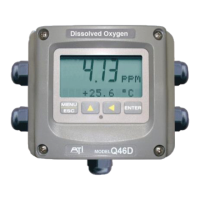ATI Q46D Dissolved Oxygen System Part 6 - Configuration
35
O&M Manual
Rev-N (4/21)
though the controller can achieve 0% or 100% anywhere within the
range.)
If the 0% point is lower than the 100% point, then the controller action
will be “reverse” acting. That is, the output of the controller will increase
if the measured value is less than the setpoint, and the output will
decrease if the measured value is larger than the setpoint. Flipping the
stored values in these points will reverse the action of the controller to
“direct” mode.
The entry value is limited to a value within the range specified in “Set
Range”, and the 0% and the 100% point must be separated by at least
1% of this range Use the LEFT arrow key to select the first digit to be
modified. Then use the UP and LEFT arrow keys to select the desired
numerical value. Press ENTER to store the new value.
PID Setpnt The measured value which the controller is attempting to maintain by
[Iout1=PID] adjusting output value. It is the nature of the PID controller that it never
actually gets to the exact value and stops. The controller is continually
making smaller and smaller adjustments as the measured value gets
near the setpoint.
PID Prop Proportional gain factor. The proportional gain value is a multiplier on
[Iout1=PID] the controller error (difference between measured value and setpoint
value.) Increasing this value will make the controller more responsive.
PID Int Integral is the number of “repeats-per-minute” of the action of the
[Iout1=PID] controller. It is the number of times per minute that the controller acts on
the input error. At a setting of 2.0 rpm, there are two repeats every
minute. If the integral is set to zero, a fixed offset value is added to the
controller (manual reset.) Increasing this value will make the controller
more responsive.
PID Deriv Derivative is a second order implementation of Integral, used to
[Iout1=PID] suppress “second-order” effects from process variables. These variables
may include items like pumps or mixers that may have minor impacts on
the measured value. The derivative factor is rarely used in water
treatment process, and therefore, it is best in most cases to leave it at
the default value. Increasing this value will make the controller more
responsive.
Set 4 mA These functions set the main 4 and 20 mA current loop output points
Set 20 mA for the transmitter. The units displayed depend on the selection made in
[Iout1=D.O.] the CONFIG menu for Iout #1 Mode. Also, when the Relay Option Board
is installed, the units will also display #1 or #2 – since there are actually
two analog outputs present in this version.
The value stored for the 4 mA point may be higher or lower than the
value stored for the 20 mA point. The entry values are limited to values
within the range specified in “Set Range”, and the 4 mA and the 20 mA
point must be separated by at least 1% of this range Use the LEFT arrow
key to select the first digit to be modified. Then use the UP and LEFT

